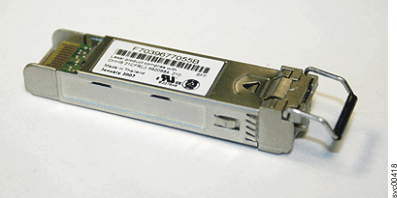When a failure occurs on an optical link,
the SFP transceiver in the port providing the link might need to be
replaced. To replace a faulty SFP transceiver with
a new one received from CRU or FRU stock, use this procedure.
Even though many of these components are hot-swappable, they are
intended to be used only when your system is not active (no I/O operations). If your system
is powered on and processing I/O operations, go to the management GUI and follow the fix procedures. Initiating the replacement actions
without the assistance of the fix procedures can result in loss of
data or loss of access to data.
Be careful when
you are replacing the hardware components that are located in the
back of the system that you do not inadvertently disturb or remove
any cables that you are not instructed to remove.
CAUTION:
Some laser
products contain an embedded Class 3A or Class 3B laser diode. Note
the following information: laser radiation when open. Do not stare
into the beam, do not view directly with optical instruments, and
avoid direct exposure to the beam. (C030)
Attention: When replacing this part, you must
follow recommended procedures for handling electrostatic discharge
(ESD)-sensitive devices.
Complete the following steps to remove and then replace an SFP transceiver:
- Carefully determine the failing physical port connection.
Important: Removing the wrong SFP transceiver might
result in loss of data access.
- Remove the cable from the SFP.
- Remove the faulty SFP transceiver from
its aperture.
Figure 1 illustrates
a typical
SFP transceiver.
Figure 1. SFP transceiver
- Unclip the handle of the SFP transceiver.
- Pull on the handle of the SFP transceiver.
- The SFP transceiver slides
out of its slot.
- Install the replacement SFP transceiver into
the aperture vacated in step 4.
- Open the lock on the replacement SFP transceiver.
- Push the new SFP transceiver into
the aperture until it stops.
- Close the release handle.
- Gently pull the SFP transceiver.
If it is installed correctly, it does not move from its aperture.
- Reconnect the optical cable.
- Confirm that the error is now fixed. Either mark the error
as fixed or restart the node depending on the failure indication originally
noted.
